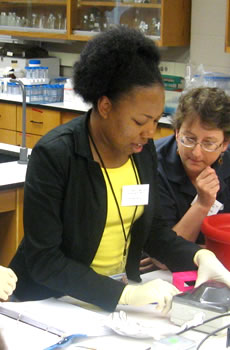Protein coding sequences/DNA modification
< Back to Protein coding sequences
Restriction enzymes
A restriction enzyme or restriction endonuclease is an enzyme that either nicks or cuts double-stranded DNA at specific recognition nucleotide sequences known as a restriction site. Many restriction sites are actually palindromic sequences in which the restriction enzyme cleaves within the recognition site. However, some restriction enzymes, known as offset cutters, cleave at a position a few nucleotides away from the recognition site. Most restriction enzymes are sensitive to the methylation state of the recognition site and won't cleave if the site is methylated. (There are also some enzymes, like DpnI, that specifically cleave methylated recognition sites.)
In synthetic biology, restriction enzymes and restriction enzyme sites are most commonly used for assembly of genetic parts into devices and systems.
Note that the DNA ligases below adhere to Assembly standard 21.
| Name | Protein | Description | Direction | Uniprot | KEGG | E.C. | Recognition sequence |
|---|---|---|---|---|---|---|---|
| BBa_K112116 | a~BamHI | ||||||
| BBa_K112117 | a~BglII | ||||||
| BBa_I716210 | BamHI endonuclease without start codon | ||||||
| BBa_K112106 | BglII endonuclease | ||||||
| BBa_K112107 | BglII endonuclease without stop codon | ||||||
| BBa_K112123 | BglII restriction enzyme |
| Samantha Liang, as a member of the 2007 UC Berkeley iGEM team, constructed the restriction enzyme protein coding sequence BBa_I716210. | Madhvi Venkatesh, Bing Xia and the [http://2008.igem.org/Team:UC_Berkeley 2008 UC Berkeley iGEM team], constructed several restriction enzyme protein coding sequences BBa_K112106-BBa_K112108 and BBa_K112117. |
References
- [http://rebase.neb.com/rebase/rebase.html Rebase] - the official restriction enzyme database
DNA Ligases
DNA ligase can link together two DNA strands that have double-strand break. In synthetic biology, DNA ligase is most commonly used during assembly of genetic parts and devices.
Note that the DNA ligases below adhere to Assembly standard 21.
| Name | Protein | Description | Tag | Direction | UniProt | KEGG | Length | Status |
|---|---|---|---|---|---|---|---|---|
| BBa_K525740 | DNA ligase from Escherichia coli (LigA) with His-tag | 2037 | Not in stock | |||||
| BBa_K525730 | DNA ligase from Escherichia coli (LigA) with PT7 and RBS | 2055 | Not in stock | |||||
| BBa_K2916000 | ArgRS protein equipped with a 10x HIS affinity tag | 1800 | Not in stock | |||||
| BBa_K3832000 | aroG | aroG (Mutant S211F) | EC 2.5.1.54 | 1053 | ||||
| BBa_K112114 | a~Ligase! | 1468 | It's complicated | |||||
| BBa_K3757000 | CtAEP1 | CtAEP1 | 1450 | |||||
| BBa_K525710 | DNA ligase from Escherichia coli (LigA) with PT7, RBS and His-tag | His-tag | 2064 | In stock | ||||
| BBa_K525010 | Fusion Protein of S-Layer SbpA and LigA with His-Tag | His-tag | 5226 | Not in stock | ||||
| BBa_K525009 | Fusion Protein of S-Layer SgsE and LigA with His-Tag | His-tag | 4434 | Not in stock | ||||
| BBa_K2916003 | GlyRS protein equipped with a 6x HIS affinity tag | 3032 | Not in stock |
| Bing Xia and the [http://2008.igem.org/Team:UC_Berkeley 2008 UC Berkeley iGEM team], constructed several ligase protein coding sequences BBa_K112111-BBa_K112114. |
Recombinases
A recombinase is an enzyme that catalyzes the exchange of short pieces of DNA between two long DNA strands, particularly the exchange of homologous regions.
For details on the different recombination systems available via the Registry, see Recombination.
Note that some of the recombinase protein coding sequences listed below adhere to Assembly standard 21.
| Name | Protein | Description | Direction | KEGG | UniProt | E.C. | Recombination site | Length |
|---|---|---|---|---|---|---|---|---|
| BBa_K1680008 | Δ1-19 Cre recombinase | 972 | ||||||
| BBa_K2460001 | φBT1 integrase | 1845 | ||||||
| BBa_K2460004 | φRv1 integrase | 1470 | ||||||
| BBa_K3120003 | A human codon-optimized SpCas9 | 4101 | ||||||
| BBa_K112115 | a~Cre | 1036 | ||||||
| BBa_I716212 | Cre (GTG start) | 1032 | ||||||
| BBa_I716213 | Cre (TTG start) | 1032 | ||||||
| BBa_J61047 | Cre DNA recombinase | 1037 | ||||||
| BBa_K1680007 | Cre recombinase | 1029 | ||||||
| BBa_K112122 | Cre with stop codon | 1032 | ||||||
| BBa_K1680019 | Cre-dronpa fusion | 1764 | ||||||
| BBa_K1680020 | Cre-dronpa fusion | 1782 | ||||||
| BBa_K1680018 | Cre-Dronpa fusion | 1746 | ||||||
| BBa_K1680017 | Cre-Dronpa Fusion | 1728 | ||||||
| BBa_J31001 | Hin-LVA | DNA invertase Hin tagged with LVA | stm:STM2772 | P03013 | none | 612 | ||
| BBa_J31000 | Hin | DNA-invertase Hin from Salmonella typhimurium | stm:STM2772 | P03013 | none | 573 | ||
| BBa_K1680024 | Dronpa caged Cre with NLS | 2487 | ||||||
| BBa_K1680023 | Dronpa caged Cre with NLS | 2469 | ||||||
| BBa_K1680022 | Dronpa caged Cre with NLS | 2451 | ||||||
| BBa_K1680021 | Dronpa caged Cre with NLS | 2433 | ||||||
| BBa_I11021 | Xis lambda | excisionase from E. coli phage lambda (removes prophage from host genome) | Forward | none | P03699 | none | 280 | |
| BBa_I11031 | Xis P22 | excisionase from E. coli phage P22 (removes prophage from host genome) | Forward | none | P04889 | none | 412 | |
| BBa_K137007 | fimE | 558 | ||||||
| BBa_K1015001 | Flippase(FLP) | 1272 | ||||||
| BBa_K313002 | flpe DNA recombinase | 1272 | ||||||
| BBa_I11020 | Int lambda | integrase from E. coli phage lambda | Forward | none | P03700 | none | 1132 | |
| BBa_I11030 | Int P22 | integrase from E. coli phage P22 | Forward | none | P04890 | none | 1225 | |
| BBa_K3254009 | Integrase Int10 | 1446 | ||||||
| BBa_K3254006 | Integrase Int5 | 1659 | ||||||
| BBa_K3254007 | Integrase Int7 | 1389 | ||||||
| BBa_K3254008 | Integrase Int8 | 1386 | ||||||
| BBa_K5487002 | Lpp-OmpA | 435 | ||||||
| BBa_K907000 | Mycobacterium Phage Bxb1 gp35, DNA integrase | 1503 | ||||||
| BBa_K907001 | Mycobacterium Phage Bxb1 gp47, DNA excisionase | 768 | ||||||
| BBa_K3254018 | original sequence of phiC31 integrase gene | 1842 | ||||||
| BBa_K361000 | Rci site-specific recombinase | 1155 | ||||||
| BBa_J70007 | recT recombination gene from Spiroplasma citri | 858 | ||||||
| BBa_K108022 | RuvA | 612 | ||||||
| BBa_K108023 | RuvB | 1011 | ||||||
| BBa_K108024 | RuvC | 522 | ||||||
| BBa_K2460007 | TG1 integrase | 1923 | ||||||
| BBa_K112001 | Xis | Xis from bacteriophage lambda, assembly standard 21 | 216 | |||||
| BBa_K112217 | {a~ihfA!} The ihf alpha gene ready to have rbs attached with stop codon, BBb format | 304 | ||||||
| BBa_K112223 | {a~ihfB!} The ihf beta gene ready to have rbs attached and stop codon, BBb format | 289 | ||||||
| BBa_K112211 | {a~int!} The integrase gene with rbs ready to be attached with stop codon, BBb format | 1075 | ||||||
| BBa_K112204 | {a~xis!} The bacteriophage lambda xis gene ready to have rbs attached and stop codon; assembly stand | 223 | ||||||
| BBa_K112219 | {ihfB!} The ihf beta gene with start and stop codons, BBb format | 285 | ||||||
| BBa_K112207 | {int!} The integrase gene with start and stop codon, BBb format | 1071 | ||||||
| BBa_K112200 | {xis!} from bacteriophage lambda; assembly standard 21 | 219 |
| Karmella Haynes, Malcolm Campbell and the [http://2006.igem.org/Davidson_2006 2006 Davidson College/Missouri Western iGEM team], designed and constructed the Hin recombinase parts BBa_J31000 and BBa_J31001. You can read more about the 2006 Davidson/Missouri Western project in their open-access paper [http://www.jbioleng.org/content/2/1/8 Engineering bacteria to solve the Burnt Pancake Problem] published in the Journal of Biological Engineering Haynes. |
| Molly Allen and the [http://2008.igem.org/Team:UC_Berkeley 2008 UC Berkeley iGEM team], constructed several ihf alpha integrase protein coding sequences such as BBa_K112211, BBa_K112217, and BBa_K112223 listed above. | Qi Liu and the [http://2008.igem.org/Team:Tsinghua 2008 Tsinghua iGEM team] designed and constructed the RuvABC resolvasome parts BBa_K108022-BBa_K108024. |
Chromatin proteins
Chromatin is the complex combination of DNA, RNA, and protein that makes up chromosomes. It is found inside the nuclei of eukaryotic cells, and within the nucleoid in prokaryotic cells. It is divided between heterochromatin (condensed) and euchromatin (extended) forms. Protein associated with chromatin are listed here.
Note that several of the protein coding sequences below, except BBa_Y00073 and BBa_Y00029, adhere to Assembly standard 28.
| Name | Protein | Description | Tag | Direction | UniProt | KEGG | Length | Status |
|---|---|---|---|---|---|---|---|---|
| BBa_Y00073 | S. pombe gene SPCC126.04c, coded for S. cerevisiae expression | 1094 | It's complicated | |||||
| BBa_Y00029 | S. pombe homolog of S.cerevisiae SGF29, recoded for expression in S.c. | 794 | It's complicated | |||||
| BBa_K106001 | Sir4, Aar1 AD part | 4077 | It's complicated | |||||
| BBa_K106002 | Sir2, Aar1 AB part | 1686 | It's complicated | |||||
| BBa_K106003 | Sir2, Aar1 BD part | 1686 | It's complicated | |||||
| BBa_K106011 | Sas2 | Sas2 histone acetyltransferase, Aar1 AB part | 1017 | It's complicated | ||||
| BBa_K106012 | Sas2 | Sas2 histone acetyltransferase, Aar1 BD part | 1014 | It's complicated | ||||
| BBa_K106013 | Esa1 | Esa1 histone acetyltransferase, Aar1 BD part | 1338 | It's complicated | ||||
| BBa_K106692 | Sir3, AarI A!D part (A!D variant!) | 2937 | It's complicated |
| Natalie Kuldell, an instructor at MIT, designed and constructed the chromatin protein parts BBa_Y00073 and BBa_Y00029. | 
|

|

|
Ryan Quan, Willis Wong, and Andrew Horowitz and the [http://2008.igem.org/Team:UCSF 2008 UCSF iGEM team] designed and constructed many of the chromatin protein parts listed above. |








